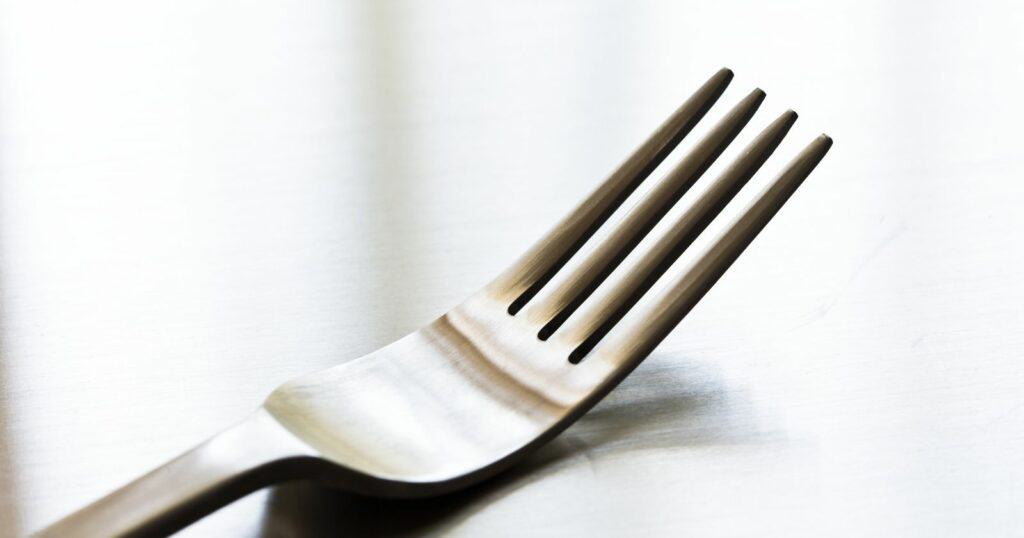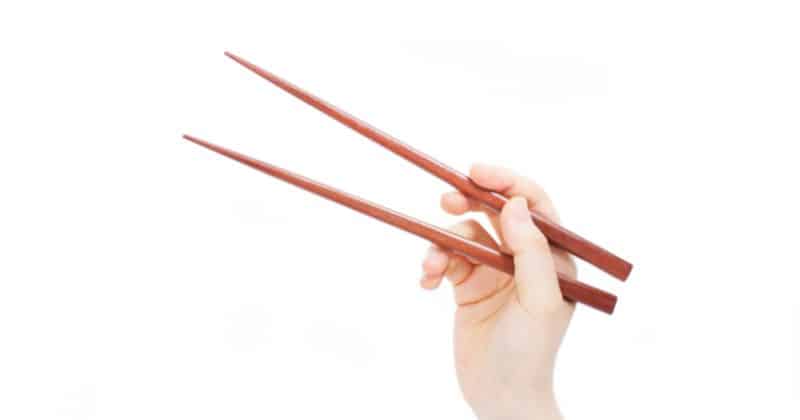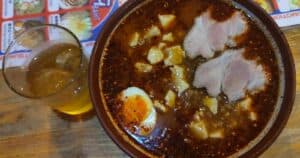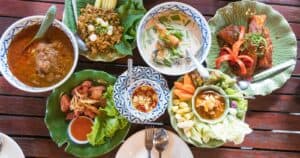Thai cuisine is renowned worldwide for its complex medley of sweet, sour, salty and spicy flavors. But when it comes to eating Thai food, many wonder: Do Thai people use chopsticks?
Unlike other Asian cuisines, Thai dining etiquette traditionally relies on forks and especially spoons rather than chopsticks. However, there are some exceptions when chopsticks make an appearance at the Thai table.
Let’s explore the cultural traditions around Thai dining etiquette, the role of the trusty spoon and fork, and when you just might see chopsticks in Thailand.
The spoon rules in Thai dining

In Thailand, a spoon takes center stage at mealtimes. For most dishes, Thai people use a spoon as their primary utensil to scoop up food and bring it to their mouth.
This dining custom reflects Thailand’s culinary history. Spoons complement key aspects of Thai food:
- Long grain sticky rice – A spoon neatly scoops up grains of glutinous rice. Chopsticks struggle with sticky rice.
- Soupy curries – Spoons easily capture every drop of flavorful, saucy curries.
- Mixed dishes – Thai meals blend various flavors and textures in one plate. A spoon mixes and gathers them well.
So the humble spoon reigns supreme at the Thai dining table. Locals value the spoon’s versatility to enjoy their cuisine’s diverse tastes and ingredients fully.
The fork’s supportive role

While less dominant than the spoon, a fork still plays an integral supporting role in Thai dining.
Thai people use a fork in the non-dominant hand (usually the left) to:
- Push or shovel food onto the spoon
- Pierce, hold, and cut firmer foods
- Aid in lifting food to the spoon
So the fork takes on more of an assistive function, helping deliver food securely to the spoon so it can then travel to the mouth.
Using fork and spoon together allows Thai people to consume meals gracefully and efficiently. This utensil team thoroughly mixes flavors and prevents spills or waste.
Chopsticks exceptions in Thai dining

The strong preference for spoon and fork dining means chopsticks are not extensively used in Thailand. Do Thai people use chopsticks? Only on occasion.
Here are some examples where you may spot chopsticks in Thai dining:
Chinese-influenced noodle dishes
Thailand’s cuisine reflects Chinese and other Asian influences. When eating Chinese-style noodle soups or stir fried noodles, locals embrace chopsticks to authentically enjoy these dishes.
The nimble chopsticks neatly pick up slippery noodles and ingredients in broth or sauce. They provide dexterity that flat spoons lack for these meals.
So for Chinese-style noodles, chopsticks align with cultural tradition.
Japanese-style meals
Another exception is Japanese dishes like sushi, sashimi, or ramen. Thai people will again adopt chopsticks as their utensil of choice to properly eat these foods.
Chopsticks help pick up bite-sized sushi rolls and slices of raw fish. They also enable slurping up chewy ramen noodles.
When in doubt, mirroring the original cuisine’s utensil customs shows respect.
Noodle soup dishes
Some noodle soup dishes like khao soi also see chopsticks come out occasionally. Locals may opt to use a set of chopsticks alongside the spoon when enjoying these soups.
The chopsticks help twirl and lift slippery noodles, while the spoon scoops up the broth.
Specific family preferences
In some families, there may be a personal preference to use chopsticks for certain everyday Thai dishes. This is family-dependent rather than the cultural norm.
Tourist restaurants
At tourist-centric Thai restaurants, chopsticks may be provided as an option to diners unfamiliar with spoon and fork dining. However, this caters to foreign customs rather than local tradition.
The cultural significance of Thai dining utensils
Thai dining etiquette surrounding utensil use reflects important cultural values:
Practicality – Spoons and forks allow Thai diners to consume meals smoothly and minimize waste.
Tradition – Utensil customs have roots in history and are passed down generations.
Identity – Utensils represent cultural traditions that distinguish Thai dining.
Social grace – Using the proper spoon, fork and occasional chopsticks makes dining feel effortless.
Utensils play both a functional and symbolic role in food culture. For Thais, learning to use spoons, forks and chopsticks appropriately is a source of dignity and hospitality.
Key Thai dining etiquette tips
Here are some top etiquette tips when enjoying Thai food:
- Hold the spoon in your dominant hand (usually right) and fork in the other hand.
- Use the spoon to scoop up food and bring it to your mouth. The fork shovels food onto the spoon.
- Don’t use a fork as a cutting utensil. Cut food with provided utensils before eating.
- Chopsticks are optional. Use them only if comfortable, such as for noodles or Japanese dishes.
- Relax your dining style. Leisurely family meals are meant to be enjoyed, not rushed.
- Slurping noodles politely is acceptable and shows you relish the dish!
Immersing in Thailand’s cherished utensil traditions enriches the cultural experience at the table.
The Origins of Thai Dining Traditions
The dining traditions we see in Thailand today arose over centuries of cultural blending and evolution. Tracing the origins provides insight into how Thai cuisine developed its distinct utensil customs.
In ancient Thailand, back to the Sukhothai period around the 1200s, eating utensils were simple. Bowls and hands were likely used for consuming rice and finger foods. Chopsticks and other tableware came later.
The influence of Chinese traders introduced chopsticks to the region hundreds of years ago. However, chopsticks did not displace eating with hands as the primary custom. They were mainly used for noodles and remained occasional utensils.
More significant change emerged during Thailand’s Rattanakosin period in the 1800s, when western colonialism increased. English traders and diplomats brought their dining habits along, including use of forks, spoons and knives.
These western-style utensils gained favor with Thailand’s nobility and royal court. King Rama V, in particular, embraced the fork and spoon as refined dining tools. The king instituted new court etiquette requiring use of fork and spoon in 1879.
This royal endorsement is credited with popularizing the spoon and fork in Thai dining. Thais adapted the utensils into a unique dining style still followed today.
So influences from both east and west shaped the blend of utensils seen in modern Thai cuisine. While chopsticks had appeared centuries before, the fork and spoon rose to become the staple pairing used for eating most Thai food.
This fusion highlights how Thai culture has historically welcomed outside influences while still preserving its distinctive local identity. The Thai dining tradition remains unique in Southeast Asia.
The Verdict on Chopsticks in Thailand
So do Thai people reach for chopsticks when dining? Not usually!
Spoons take center stage as the preferred utensil for scooping and mixing flavors in Thai cuisine. Forks provide handy assistance.
While chopsticks do make occasional appearances in Thai dining, particularly with Chinese-influenced noodle dishes, they are not the default option.
Instead, Thai dining etiquette emphasizes the efficiency, tradition and grace of the spoon and fork duo. Utensils act as subtle ambassadors of Thailand’s cherished food culture.
So next time you enjoy pad thai or green curry, savor the flavors using the traditional tools – just as the locals do. The spoon and fork will ensure every morsel lands happily on your tastebuds!





